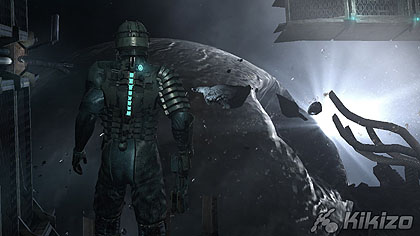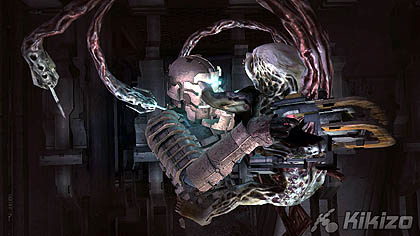Dead Space: Impressions and EA Interview
EA isn't known for original IP, but that might be about to change. We talk to EA's Glen Schofield and give our impressions of what could be this year's Bioshock.
Page 2
Kikizo: So is there an EA studio name attached to this project, if you have assembled the team up from around EA as you've gone along?
Schofield: Well, it's EA Redwood Shores. I wish we had a better name - we call it EARS. Maxis was brought into that too, so it's part Maxis and part Redwood Shores, so we came up with MARS, but that just sounded kind of dumb [laughter] so we're sticking with EA Redwood Shores for now. That's actually the corporate location as well, but we have a really beautiful studio there.
Kikizo: We've not really seen science fiction with survival horror before. Can you tell us more about the storyline for this mix and the character, Isaac Clarke?
Schofield: So way in the future, we're now at the point where we're going into deep, deep space, and we're mining on a planetary level, where we take a dead planet and completely take it apart over a couple of years and mine the whole planet. The Ishimura is this big, big ship a couple of kilometres long, and it goes out there but loses contact with earth. It's not uncommon to lose contact, but after three or four days they send out a repair shuttle with a repair crew and a security crew, to go and see if it's just communications or something, and realise something's up. Isaac arrives and discovers that this invader has taken over the ship and has twisted the crew beyond recognition, he's weaponless and terrified, and has to fight for his survival using tools and stuff - this is a mining ship, it's not a military ship. He's an engineer, so he's not an idiot, and he has to pick things up as he goes.
Kikizo: A lot of the traditional HUD information is displayed around Isaac, and on his suit, how workable is this?
Schofield: We call the suit the 'rig'. It shows your meter that slows down time. You also have the air timer on there. On this particular suit that's it, but we do upgrade the suits so you get a little bit more armour, but it's not like they're marine suits. They're more like heavy-duty mining suits. Like the one you saw earlier had more spines on it, and that was a level three suit. And then also there's the ammo count. You have a limited inventory, and that's something you can upgrade as well. There are other screens, that will show you the objectives, show you video logs, audio logs, and text logs. You saw an example of the video log, showing that the technology works - it was just a member of our team doing that voice.
The other characters in the game - survivors and other people that come with you - when you bump into them, there'll be scripted events in the background and interaction with them. There aren't going to be any cut-scenes; everything about the game is about trying to keep you in it, that's why there's no HUD, that's why your character sees a video log in front of him rather than it taking over your screen. So that's what we show, as well as the 3D map that looks pretty cool, zooming in and zooming out, showing your objectives in 3D. The levels aren't linear, so you'll see three or four of your objectives on it and you decide which one to approach, and it will shows you a line on the 3D map of the best way to go to get there.
Kikizo: So why third person, then? Valve argues that you're immersed as Gordon in Half-Life 2 because you never see Gordon. What makes third-person work here?
Schofield: The vision of the game that I wanted to make for a long time was that it was always third person. With first person, I love Condemned, F.E.A.R., and Bioshock - but I didn't really feel my character as much. Here, I wanted you to feel like your character is in peril. You saw that horrific kill [where the player died] earlier? That is the tamest kill we have! [laughter] He gets ripped apart, he's completely dismemberable, including... well, when he gets cut in half... we have this technology we call procedural tentacles, so they kind of move with the wind, so when his guts are hanging out, those are procedural! [laughter] We've spent a lot of time on how he dies. He's also going to add to the atmosphere himself; if he hears a sound he'll look to see what it was, it makes it creepier. If it were first person, I'd have to put a HUD on, and we don't want that. I mean, putting the character on the screen, is a big burden on the dev team! Thousands and thousands of animations; he's taking up god knows how much memory, all that stuff. So when you make that decision, it's a big decision, but it was important enough to make.
Kikizo: The level you showed us, Chapter 3, you say this level is 1 hour 20 minutes in total. This seems quite long, especially considering the mood. What is the thinking behind this?
Schofield: Actually, I'm happy about the length of the level, because there's so much in there... it's the kind of level where you can say, OK, I'll stop here and go eat, or stop and play tomorrow, whatever. By the time you go through that level you feel like you've done so much stuff. I'm pretty happy about that, because usually when you're designing a game, a designer will go, "OK, well I think this level is going to be about 40 minutes". And it always ends up being eighteen! And some tester runs through it in ten! [laughter]. And you're like, I just spent like a million bucks on that level! So this time, in this level, me or a tester, we could probably get through this level in about 45 minutes. I think that hardcore gamers will probably get through in 50 minutes to an hour. But you know, I think that's a good length for survival horror. It's intense; it's a slower pace. If I had really small levels at that slower pace, it wouldn't feel right. So I feel really good about the size.








 Satoru Iwata Video Interview - the late Nintendo president spoke with Kikizo in 2004 as 'Nintendo Revolution' loomed.
Satoru Iwata Video Interview - the late Nintendo president spoke with Kikizo in 2004 as 'Nintendo Revolution' loomed. Kaz Hirai Video Interview - the first of Kikizo's interviews with the man who went on to become global head of Sony.
Kaz Hirai Video Interview - the first of Kikizo's interviews with the man who went on to become global head of Sony. Ed Fries Video Interview - one of Xbox's founders discusses an epic journey from Excel to Xbox.
Ed Fries Video Interview - one of Xbox's founders discusses an epic journey from Excel to Xbox. Yu Suzuki, the Kikizo Interview - we spend time with one of gaming's most revered creators.
Yu Suzuki, the Kikizo Interview - we spend time with one of gaming's most revered creators. Tetris - The Making of an Icon: Alexey Pajitnov and Henk Rogers reveal the fascinating story behind Tetris
Tetris - The Making of an Icon: Alexey Pajitnov and Henk Rogers reveal the fascinating story behind Tetris Rare founders, Chris and Tim Stamper - their only interview? Genuinely 'rare' sit down with founders of the legendary studio.
Rare founders, Chris and Tim Stamper - their only interview? Genuinely 'rare' sit down with founders of the legendary studio. The History of First-Person Shooters - a retrospective, from Maze War to Modern Warfare
The History of First-Person Shooters - a retrospective, from Maze War to Modern Warfare